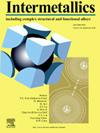Machine learning for obtaining values of thermomechanical processing parameters of high-entropy alloys with desirable strength and ductility
IF 4.8
2区 材料科学
Q2 CHEMISTRY, PHYSICAL
引用次数: 0
Abstract
Machine learning offers a promising and cost-effective approach to optimize thermomechanical processing and inverse design of high-entropy alloys. To obtain values of thermomechanical processing parameters including thickness reduction during rolling together with post-deformation annealing temperature and time of an equiatomic CoCrFeNiMn high-entropy alloy with desirable strength and ductility, we use neural networks for which and apply data augmentation techniques to enhance learning and performance. Besides, the performance of various other techniques, such as linear regression, k-nearest neighbors, decision trees, and ensemble models (random forest, bagging, gradient boosting, XGBoost, AdaBoost) were compared with that of neural networks. The results show that neural networks achieve superior performance, namely, an average MAPE of 8 % and an average R-squared of 91 %. The neural network was experimentally validated for three samples with target yield strengths of 450 MPa, 650 MPa, and 800 MPa, which resulted in actual values of 415 ± 22 MPa, 620 ± 31 MPa, and 745 ± 38 MPa, respectively, with uniform elongations closely matching the target of 15 %. The results demonstrate the potential of machine learning in neural networks for obtaining the values of processing parameters for high-performance new alloys.
利用机器学习获得具有理想强度和延展性的高熵合金的热力加工参数值
机器学习为优化高熵合金的热机械加工和逆向设计提供了一种有前途且经济有效的方法。为了获得具有理想强度和延展性的等原子CoCrFeNiMn高熵合金在轧制过程中厚度减少、变形后退火温度和时间等热处理参数的值,我们使用神经网络并应用数据增强技术来增强学习和性能。此外,还将线性回归、k近邻、决策树和集成模型(随机森林、bagging、梯度增强、XGBoost、AdaBoost)与神经网络的性能进行了比较。结果表明,神经网络取得了优异的性能,即平均MAPE为8%,平均r平方为91%。对目标屈服强度为450 MPa、650 MPa和800 MPa的三种样品进行了实验验证,结果表明,该神经网络的实际屈服强度分别为415±22 MPa、620±31 MPa和745±38 MPa,均匀伸长率接近15%的目标。结果表明,神经网络中的机器学习在获得高性能新合金的加工参数值方面具有潜力。
本文章由计算机程序翻译,如有差异,请以英文原文为准。
求助全文
约1分钟内获得全文
求助全文
来源期刊

Intermetallics
工程技术-材料科学:综合
CiteScore
7.80
自引率
9.10%
发文量
291
审稿时长
37 days
期刊介绍:
This journal is a platform for publishing innovative research and overviews for advancing our understanding of the structure, property, and functionality of complex metallic alloys, including intermetallics, metallic glasses, and high entropy alloys.
The journal reports the science and engineering of metallic materials in the following aspects:
Theories and experiments which address the relationship between property and structure in all length scales.
Physical modeling and numerical simulations which provide a comprehensive understanding of experimental observations.
Stimulated methodologies to characterize the structure and chemistry of materials that correlate the properties.
Technological applications resulting from the understanding of property-structure relationship in materials.
Novel and cutting-edge results warranting rapid communication.
The journal also publishes special issues on selected topics and overviews by invitation only.
 求助内容:
求助内容: 应助结果提醒方式:
应助结果提醒方式:


